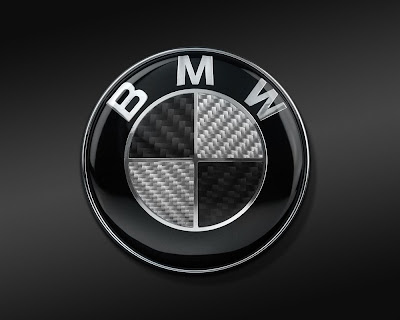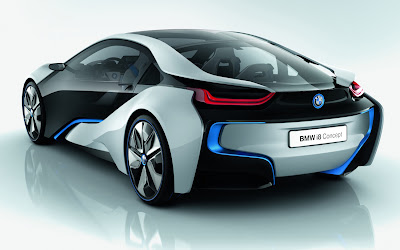
BMW has fully dedicated itself to the battery-electric driving revolution by setting up a whole new sub-brand - BMW i - devoted to emission-free motoring. Now, the i group has released details of two concept cars that appear set to become production models within a few years.
The i3 concept is a fully-electric city car with an everyday driving range of about 160 km (100 miles) per charge, and the i8 is a sporty 4-seater plug-in hybrid that combines electric and petrol drive to give a good compromise among emission-free commuting and petrol-powered range and performance.
Both cars make widespread use of carbon fiber-reinforced plastic (CFRP) to keep weight down, and both offer a raft of fascinating new driver assist and efficiency initiatives that look likely to make it throughout to the real world.
The BMW i3 - all-electric city boy
First up is the town car getabout - the i3. As a fully electric car, it's mainly aimed at urban commuting, but its battery range is conditioned to a level a little beyond that. On the FTP72 cycle, it's rated for 225 km (140 miles), but BMW says the car's everyday range, being driven by regular lead-foot clowns like you and I, is more like 160 km (100 miles).
Acceleration is in the range of 8 seconds to 100 kph (62 mph), but it should be fairly zippy off the line, as it develops 100 percent of its torque from a standstill. Top speed should be about 150 kph (93 mph) - but that's electronically limited, because autobahn speeds can be brutally draining on most electric vehicles.
The i3's large battery pack sits under the floor of the vehicle in a slab that's protected from crash damage by a number of buffer zones in the structure. As batteries are typically the most expensive part of an electric vehicle, you'd surely want to protect them.
The 170 hp electric motor, single-gear drive system and differential are located over the driven rear axle, and there's room there for an optional range extender - a high efficiency petrol engine that putts away and brings forth electricity to charge the batteries. With the range extender on board, you can roughly double the i3's range, and fill up at any petrol station.
The BMW i8 - a clean, hybrid all-rounder
While the i3 is best suited to round-town usage, the i8 has broader dreams. It uses the same electric motor as the i3, this time mounted over the front axle, in conjunction with a three-cylinder, 220 horsepower petrol engine over the rear axle. Blended, you're looking at a 354 horsepower all-wheel-drive with 550 Nm of torque.
All wheel drive isn't altogether accurate though - the i8 constantly proportions the power between the front and rear drive systems according to how the car is being driven. With a much smaller battery system than the i3, the i8 can only manage around 35 km (20 miles) in full electric drive mode - but then, that would cover an emission-free commute for the majority of people.
The true value of the hybrid system comes with longer range driving, where on the EU cycle, the i8 carries off a banging 104 miles per gallon (2.7 liters per 100 km). Driven hard, the fuel consumption will double, but don't forget that the Toyota Prius is advertised as a 50 mpg hybrid and is nowhere near as much fun.
Like the i3, the i8's top speed is electronically governed, but this time at a very sporty 250 kph (155 mph), so it'll hold its head high on any autobahn. The i8 will hit 100 kph (62 mph) in a brisk 5 seconds or less, decent sports car territory there, and the car's entire underbelly is totally enclosed to boost aerodynamic efficiency and cut down fuel consumption.
Common features
The i3 and i8 share a contrive philosophy and a number of characteristics worth talking about.
LifeDrive component separation and CFRP
Both cars are built on the LifeDrive philosophy, which separates the drive and passenger components and treats each differently. The Drive components, including engines, suspension, structural and crash protection functions, are chiefly housed in aluminum structures, while the Life elements - effectively the passenger cell - are designed using high strength, featherweight, carbon fiber-reinforced plastic (CFRP).
Accelerator/Decelerator pedal and regenerative braking
Even as they incorporate it in different ways, both cars feature a regenerative braking system to hold the battery topped up and cut down wear on the conventional brake system.
On the i3, this comes in the form of an accelerator/decelerator pedal, with which you're either on the gas, coasting, or braking depending on how far the pedal is pressed down. BMW approximations that around town, you can do as much as 75 percent of your braking this way - that is,without lifting your foot and hitting the brake pedal at all - and in our experience with other regenerative braking systems, that's not far off the mark. The regenerative braking system can contribute back up to 20 percent extra range to the battery charge, and it's very sensitive to use.
The press release is less clear about how the system works on the i8 - or how it works in with the petrol engine - but we assume it's somewhat similar, including a brake pedal which seems to use the regenerative system for the first part of the pedal travel, and the conventional disc brakes beyond that.
Intelligent Electronics: Proactive Front Protection, Parking Assistant, Traffic Jam Assistant
Driver aids abound on the i3 and i8, including frontal collision warning systems that flash, beep and eventually hit the brakes for you if they find out you're going to hit something.
Parking Assistant is a press-button parallel parking system that not only manages the steering to lead you into your parking spot, but also handles the accelerator, brake and gear changes for you, even if the park takes a few moves.
Traffic Jam Assistant is a wonderful stress-saver that holds a constant distance from the car in front, all the way from standstill to 40 kph(25 mph), and actually provides active steering input as well to keep you inside your lane. You just need to keep one hand on the steering wheel as you drift off to sleep.
Smartphone integration
Equally with all things in the future, the i3 and i8 will be highly integrated with your smartphone. You can use your phone to find your car,lock it, unlock it, make it beep its horn or flash its lights.
Your smartphone can also tell you where the nearest charging stations are, and through integration with the navigation system, it can tell you where to walk once you've parked your car to get to your destination.
ECO PRO mode
ECO PRO mode immediately changes the accelerator response characteristics so that you're constantly using less power for a given throttle application. It caps top speed at anywhere between 90 and 120 kph (56 and 75 mph), and it reduces the effectiveness of heating and cooling systems so they consume less too.
Whenever things get really scary, ECO PRO+ mode sets in and basically closes down everything except the absolute essentials, like demisters and whatnot. Top speed is reined in to 90 kph (56 mph) and you can be certain you're getting maximum mileage.
It'll be fascinating to see what alterations on these two concepts if and when they hit the market - but it looks fairly clear that through its i division, BMW is serious about emission-free motoring and ready to get into the game with some pretty competitive products.
View this site: cheap business class flight | budget class airfares